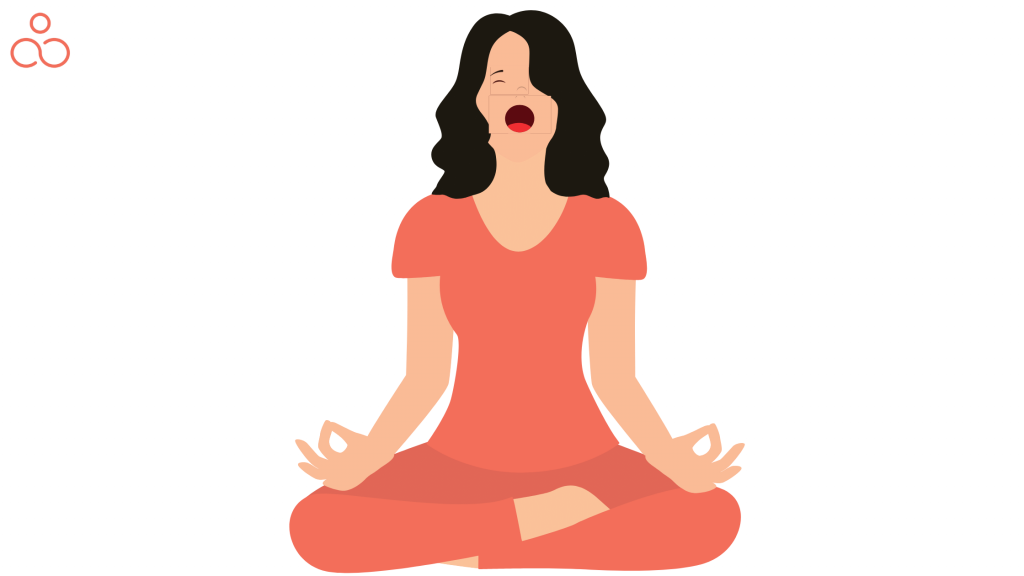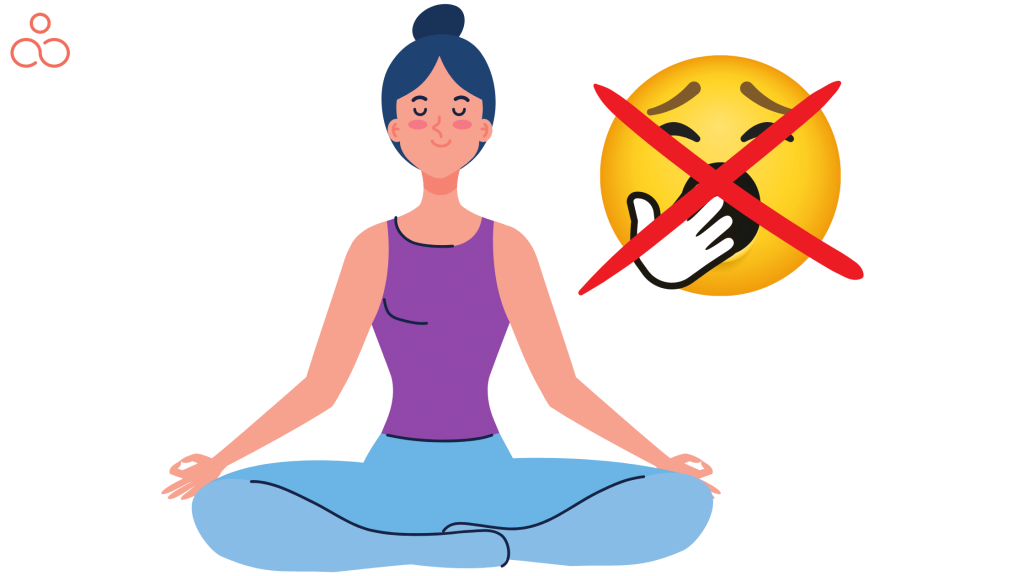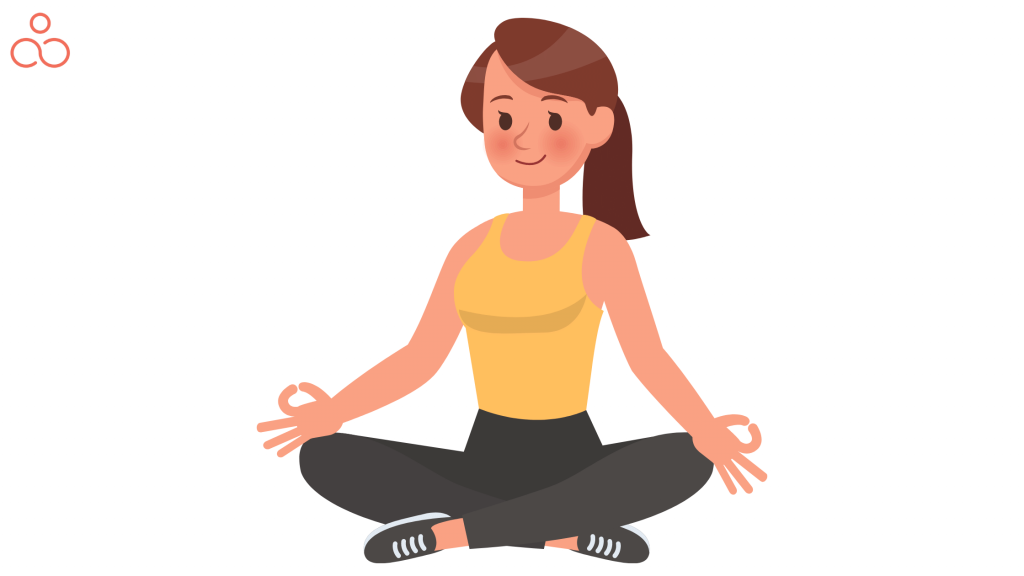In the tranquil realms of meditation, where peace and serenity reign supreme, an unexpected guest often emerges—yawning. Yes, you read that right: yawning during meditation. This seemingly incongruous phenomenon intrigues practitioners worldwide.
What purpose does it serve? Is it a mere coincidence or a hidden key to unlocking profound insights? Join us as we delve into the enigmatic world of yawning during meditation and explore its secrets.
Yawning During Meditation

Yawns are typical during meditation and yoga and people even practice sleep meditation or Yoga Nidra. But in reality, a lot of people discover that yawns occur very frequently and some even complain about yawning a lot during meditation. There are several reasons why this might happen.
First of all, as our breathing gets shallow, we naturally yawn. This can occur while we’re feeling at ease or drowsy. Deep calm brought on by meditation is frequently enough to set off the reaction. Second, yawning can help the brain receive more oxygen and blood. During meditation, blood flow might slow down when we turn within. Yawning promotes blood flow and increases brain oxygenation. Last but not least, yawning could indicate that we are letting off tension. We may also physically relax as we let go of thoughts and other distractions. A yawn could follow a sensation of tranquilly and lightness brought on by this.
Whatever the cause, you shouldn’t be alarmed if you find yourself dozing off during meditation. Simply said, it is a sign that your body is adapting to the practice organically.
Why do we yawn, and what is it?
Yawning is a reflex action characterized by the opening of the mouth wide while inhaling deeply, followed by a prolonged exhalation. It is a common behaviour observed in humans and many other animals. Here are some key points explaining what yawning is and why we do it:
- Physiological mechanism: Yawning involves the stretching of the jaw and facial muscles, accompanied by an intake of a deep breath. It triggers a cascade of physiological changes in the body.
- Oxygenation and brain function: Yawning is believed to play a role in increasing oxygen intake and enhancing brain function. The deep inhalation during a yawn helps to draw in more oxygen and remove excess carbon dioxide, promoting alertness and improving cognitive performance.
- Regulation of brain temperature: Yawning is thought to assist in regulating brain temperature. The deep inhalation during a yawn may cool the brain by increasing blood flow and reducing its temperature, which can help in maintaining optimal cognitive functioning.
- Tension release: Yawning has been proposed as a mechanism for releasing tension and stress. It is often observed in situations of fatigue or boredom, but it can also occur in times of relaxation. Yawning may help relax the muscles, relieve tension, and create a sense of calmness.
- Contagious nature: Yawning is contagious, meaning that witnessing or hearing someone yawn can trigger a yawn in others. This phenomenon is believed to have social and empathetic functions, helping to synchronize and bond individuals within a group.
- Sleep regulation: Yawning is associated with sleep regulation. It often occurs before and after sleep, signalling transitions in the sleep-wake cycle. Yawning may serve as a preparatory action, helping to initiate sleep or promote wakefulness.
While the exact reasons behind yawning remain somewhat elusive, these points shed light on its potential functions related to oxygenation, brain regulation, tension release, social bonding, and sleep. Yawning is a complex and intriguing behaviour that continues to be studied by scientists in order to uncover its full significance and implications for our well-being.
What Releases From The Brain When We Yawn?
The act of yawning triggers the release of various chemicals in the brain, helping to regulate various physiological and psychological processes. While the exact mechanisms are not fully understood, here is a detailed explanation of some of the chemicals that may be involved in the process:
- Dopamine: Dopamine is a neurotransmitter associated with reward, pleasure, and motivation. Yawning may trigger the release of dopamine in certain brain regions, leading to feelings of contentment and relaxation.
- Serotonin: Serotonin is a neurotransmitter known for its role in mood regulation, sleep, and overall well-being. Yawning has been linked to increased serotonin release, which could contribute to a sense of calmness and improved mood.
- Endorphins: Yawning is believed to stimulate the release of endorphins in the brain. Endorphins are natural painkillers and mood elevators, leading to feelings of euphoria and a reduction in discomfort.
- Oxytocin: Oxytocin, often referred to as the “love hormone” or “bonding hormone,” plays a crucial role in social bonding and attachment. Yawning may trigger the release of oxytocin, fostering a sense of connectedness and empathy.
- Cortisol: Cortisol is a hormone released in response to stress and perceived threats. Yawning has been associated with a reduction in cortisol levels, suggesting that it may help alleviate stress and promote relaxation.
- Nitric Oxide: Yawning is also thought to increase the production of nitric oxide in the brain. Nitric oxide is a vasodilator, meaning it helps widen blood vessels, leading to improved blood flow and circulation.
What Effects Does Yawning Have on the Body?
Yawning serves several important functions for the body, supporting overall health and well-being. Here are six key points on what yawning does for the body:
- Brain Cooling: Yawning may help regulate brain temperature. When we yawn, cool air enters our mouth, leading to increased blood flow to the brain and potentially aiding in cooling the brain, which is essential for optimal cognitive function.
- Increased Oxygen Intake: Yawning involves taking a deep breath, which allows for a rapid intake of oxygen. This can help increase oxygen levels in the bloodstream, promoting alertness and overall brain function.
- Stress Reduction: Yawning has been associated with a decrease in cortisol, the stress hormone. The act of yawning may help alleviate stress and induce a sense of relaxation, fostering a calmer state of mind.
- Brain Activation: Yawning activates various areas of the brain, including those responsible for consciousness and arousal. It may play a role in maintaining the brain’s alertness and readiness for tasks.
- Social Communication: Yawning can be a form of nonverbal communication, conveying emotional states such as tiredness or boredom. It is also contagious, often triggered by observing others yawning, indicating its role in social bonding and empathy.
- Enhancing Mood: Yawning is believed to trigger the release of certain neurotransmitters, such as dopamine and serotonin, which are associated with mood regulation and a sense of well-being. This can contribute to an improved emotional state.
The Relationship between Yawning and tearing during meditation
Yawning and tearing are two additional phenomena that can occur during meditation. Here are key points explaining the relationship between yawning, tearing, and meditation:
| Parameters | Relationship |
| Relaxation response | Yawning and tearing are often associated with the relaxation response triggered by meditation. As the mind and body enter a state of deep relaxation, it is not uncommon for these physiological responses to manifest. |
| Release of emotional and energetic blockages | Yawning and tearing during meditation may signify the release of emotional and energetic blockages stored in the body. Meditation allows individuals to connect with their emotions and subconscious, potentially leading to the release of pent-up feelings and tensions. |
| Cleansing and purification | Tearing can serve as a form of emotional cleansing and purification during meditation. It is believed to help release emotional residue and bring a sense of emotional release and clarity. |
| Enhanced self-awareness | Yawning and tearing can heighten self-awareness during meditation. By observing these phenomena, practitioners can become more attuned to their bodily sensations and emotional states, deepening their understanding of their inner experiences. |
| Indicators of deep relaxation | Yawning and tearing are often indicative of a deep state of relaxation achieved during meditation. They can signal that the mind and body are entering a state of profound calmness and openness. |
| Integration of mind and body | Yawning and tearing can represent the integration of the mind and body during meditation. As practitioners achieve a state of deep presence and focus, these physical responses may indicate a harmonization between mental and physical states. |
| Individual variations | The occurrence and frequency of yawning and tearing during meditation can vary among individuals. Some may experience these phenomena regularly, while others may rarely encounter them. Each person’s meditation practice is unique, and these responses should be understood in the context of personal experiences. |
How to avoid yawning while meditating?

Experiencing yawning during meditation is a natural occurrence and shouldn’t be a cause for concern. However, if you find that excessive yawning disrupts your focus or meditation practice, here are some strategies to help minimize or avoid yawning:
- Adequate rest: Ensure you are well-rested before engaging in meditation. Fatigue can increase the likelihood of yawning. Prioritize getting enough sleep to promote alertness during your practice.
- Mindful posture: Maintain an upright and engaged posture during meditation. Slouching or reclining can induce drowsiness and increase the likelihood of yawning. Sit tall with a straight spine, supporting your body while remaining alert.
- Deep, intentional breathing: Practice deep and intentional breathing during meditation. Engage in full inhalations and exhalations, focusing on the sensation of breath entering and leaving your body. This can help oxygenate your system and reduce yawning.
- Engage the senses: If you feel drowsy or prone to yawning, try incorporating sensory cues to stimulate your attention. Open your eyes slightly, focus on a specific object, or introduce gentle ambient sounds to keep your mind engaged.
- Vary meditation techniques: If yawning persists during a particular meditation technique, try exploring different methods. Experiment with guided visualizations, mantra repetition, or walking meditation. Variety can help maintain interest and reduce yawning.
- Embrace yawning: Instead of resisting or becoming frustrated with yawning, accept it as part of your meditation experience. Cultivate a sense of curiosity and observe how yawning affects your state of mind and body. Allow it to pass without judgment or attachment.
7 Tips for preventing yawning during meditation

If you find that yawning interrupts your meditation practice, here are seven tips to help prevent yawning and maintain focus:
- Energize your body: Before meditating, engage in light physical activity to invigorate your body and increase alertness. Stretching, gentle yoga poses, or a brisk walk can help awaken your senses and reduce the likelihood of yawning.
- Optimal environment: Create a meditation space that is well-ventilated and free from excessive warmth or stuffiness, as these conditions can induce drowsiness and yawning. Choose a comfortable temperature and ensure adequate fresh air circulation.
- Proper posture: Sit in an upright and supported posture during meditation to promote alertness and prevent slouching, which can lead to yawning. Align your spine, relax your shoulders, and find a comfortable yet engaged position.
- Adjust meditation duration: If you constantly find yourself yawning during long meditation sessions, consider shortening the duration and gradually increasing it over time. Starting with shorter sessions can help maintain focus and reduce fatigue.
- Mindful eating and hydration: Before meditating, avoid heavy meals that can induce drowsiness. Instead, opt for a light and balanced snack or meal. Additionally, ensure you are adequately hydrated to support mental alertness and minimize fatigue.
- Engage your mind: If you notice yourself drifting or feeling drowsy, actively engage your mind by focusing on the sensations of your breath, repeating a mantra, or visualizing calming imagery. Directing your attention can help maintain focus and minimize yawning.
- Mindfulness of energy: Cultivate awareness of your energy levels throughout the day. If you consistently feel fatigued during a particular time, consider scheduling your meditation practice during a period when you are naturally more alert.
Remember, it’s important to approach yawning with acceptance and non-judgment. If yawning occurs despite your efforts, gently acknowledge it and redirect your focus back to your meditation practice. Over time, as you deepen your practice and establish a routine, you may find that yawning becomes less frequent or ceases altogether.
FAQs
Why am I yawning while breathing during meditation?
Yawning while breathing during meditation can occur due to the body’s natural relaxation response and increased oxygen intake.
Why do I yawn during meditation?
Yawning during meditation can occur due to the body’s relaxation response and increased oxygen intake. It is a natural physiological reaction.
Is yawning during meditation a sign of boredom or lack of focus?
Not necessarily. Yawning during meditation is often unrelated to boredom or lack of focus. It can simply be a normal bodily response during the practice.
Can yawning during meditation affect the depth of my practice?
Yawning itself doesn’t inherently impact the depth of your practice. It’s more important to observe and accept it without judgment, allowing your focus to return to your meditation object.
How can I differentiate between natural fatigue and excessive yawning during meditation?
Pay attention to your overall energy levels. If you consistently feel fatigued and yawning excessively, it may be a sign of insufficient rest or sleep, rather than solely related to meditation.
Is yawning during meditation beneficial or detrimental to my practice?
Yawning during meditation is typically neutral and doesn’t directly affect the benefits of your practice. It’s more about maintaining a non-judgmental attitude and staying present.
Are there any specific techniques to reduce or prevent yawning while meditating?
While it’s difficult to completely prevent yawning, staying well-rested, maintaining an upright posture, and practicing deep, intentional breathing can help minimize its frequency.
What is the relationship between yawning and relaxation during meditation?
Yawning is often associated with relaxation, as it can be a sign of the body releasing tension. It can indicate that you are entering a state of deep relaxation during meditation.
Does the frequency of yawning during meditation change over time?
The frequency of yawning during meditation can vary from person to person and may change over time. Some individuals may experience it more frequently in the beginning, while others may not experience it at all.
Can yawning during meditation indicate the release of emotional or physical tension?
Yawning can sometimes be associated with the release of emotional or physical tension. It may be an indication that you are letting go of stress or stored energy during your meditation practice.
Why is there excessive yawning during meditation sometimes?
Excessive yawning during meditation can occur due to factors such as fatigue, lack of sleep, or the body’s release of accumulated tension and energy during the practice.
Conclusion
In the realm of meditation, yawning becomes a fascinating phenomenon, intertwined with relaxation, emotional release, and the mind-body connection. Rather than an obstacle, yawning during meditation can be viewed as a sign of progress and deepening in one’s practice.
Embracing it with acceptance and curiosity, practitioners can tap into the transformative power of meditation, unravelling the mysteries of the mind and body on their journey of self-discovery.

